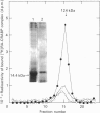Abstract
A biologically active bifunctional retinoid, ethyl 14-carboxyretinoate, has been synthesized and shown to bind cellular retinoic acid (RA)-binding protein (CRABP) via its free carboxy group. We describe herein the synthesis of 14-carboxy-13-cis-retinamide-Sepharose 4B, which is an affinity matrix bearing an all-trans-RA moiety, and thus was used to purify and characterize CRABP from chick-embryo skin. An amide bond was first formed between the free carboxy group of the retinoid and a primary amino group of aminohexyl-Sepharose 4B, by reaction with carbodi-imide, and the ester group of the resin-bound retinoid was then hydrolysed in an alkaline medium. Polyacrylamide-gel electrophoresis and f.p.l.c. Superose column-chromatographic analysis demonstrated that the affinity-purified CRABP (Mr 15,000) was close to electrophoretic homogeneity (greater than 90%) and specifically interacts with RA. By using affinity gel chromatography, conversion of holo-CRABP into apo-CRABP by treatment with p-hydroxymercuribenzoate and a possible involvement of a thiol group in RA binding to CRABP were established. This affinity procedure provides several advantages: (i) 14-carboxy-13-cis-retinamide-Sepharose exhibited high efficiency and selectivity for RA-binding protein (i.e. retinol- or fatty-acid-binding proteins did not bind); (ii) the presence of the amide linkage between the ligand and the matrix makes this affinity resin relatively stable to cytosolic enzymes; and (iii) other RA-binding proteins, e.g. nuclear receptor(s), may be purified.
Full text
PDF





Images in this article
Selected References
These references are in PubMed. This may not be the complete list of references from this article.
- Bashor M. M., Toft D. O., Chytil F. In vitro binding of retinol to rat-tissue components. Proc Natl Acad Sci U S A. 1973 Dec;70(12):3483–3487. doi: 10.1073/pnas.70.12.3483. [DOI] [PMC free article] [PubMed] [Google Scholar]
- Bonelli F. C., De Luca L. M. A high-performance liquid chromatographic technique that separates cellular retinol binding protein from cellular retinoic acid binding protein. Anal Biochem. 1985 May 15;147(1):251–257. doi: 10.1016/0003-2697(85)90035-1. [DOI] [PubMed] [Google Scholar]
- Brand N., Petkovich M., Krust A., Chambon P., de Thé H., Marchio A., Tiollais P., Dejean A. Identification of a second human retinoic acid receptor. Nature. 1988 Apr 28;332(6167):850–853. doi: 10.1038/332850a0. [DOI] [PubMed] [Google Scholar]
- Giguere V., Ong E. S., Segui P., Evans R. M. Identification of a receptor for the morphogen retinoic acid. Nature. 1987 Dec 17;330(6149):624–629. doi: 10.1038/330624a0. [DOI] [PubMed] [Google Scholar]
- LOWRY O. H., ROSEBROUGH N. J., FARR A. L., RANDALL R. J. Protein measurement with the Folin phenol reagent. J Biol Chem. 1951 Nov;193(1):265–275. [PubMed] [Google Scholar]
- Laemmli U. K. Cleavage of structural proteins during the assembly of the head of bacteriophage T4. Nature. 1970 Aug 15;227(5259):680–685. doi: 10.1038/227680a0. [DOI] [PubMed] [Google Scholar]
- Lotan R. Effects of vitamin A and its analogs (retinoids) on normal and neoplastic cells. Biochim Biophys Acta. 1980 Mar 12;605(1):33–91. doi: 10.1016/0304-419x(80)90021-9. [DOI] [PubMed] [Google Scholar]
- Ong D. E., Chytil F. Cellular retinoic acid-binding protein from rat testis. Purification and characterization. J Biol Chem. 1978 Jul 10;253(13):4551–4554. [PubMed] [Google Scholar]
- Ong D. E., Crow J. A., Chytil F. Radioimmunochemical determination of cellular retinol- and cellular retinoic acid-binding proteins in cytosols of rat tissues. J Biol Chem. 1982 Nov 25;257(22):13385–13389. [PubMed] [Google Scholar]
- Sani B. P., Banerjee C. K. Purification and properties of retinoic acid-binding protein from chick-embryo skin. Biochem J. 1978 Aug 1;173(2):643–649. doi: 10.1042/bj1730643. [DOI] [PMC free article] [PubMed] [Google Scholar]
- Sani B. P., Condon S. M., Banerjee C. K. Purification and properties of retinol- and retinoic acid-binding proteins from a transplantable mouse colon tumor. Biochim Biophys Acta. 1980 Jul 24;624(1):226–236. doi: 10.1016/0005-2795(80)90242-1. [DOI] [PubMed] [Google Scholar]
- Sani B. P., Condon S. M., Brockman R. W., Weiland L. H., Schutt A. J. Retinoic acid-binding protein in experimental and human colon tumors. Cancer. 1980 Mar 15;45(5 Suppl):1199–1206. doi: 10.1002/1097-0142(19800315)45:5+<1199::aid-cncr2820451326>3.0.co;2-d. [DOI] [PubMed] [Google Scholar]
- Sani B. P., Hill D. L. A retinoic acid-binding protein from chick embryo skin. Cancer Res. 1976 Feb;36(2 Pt 1):409–413. [PubMed] [Google Scholar]
- Sani B. P., Hill D. L. Retinoic acid: a binding protein in chick embryo metatarsal skin. Biochem Biophys Res Commun. 1974 Dec 23;61(4):1276–1282. doi: 10.1016/s0006-291x(74)80422-5. [DOI] [PubMed] [Google Scholar]
- Shealy Y. F., Krauth C. A., Riordan J. M., Sani B. P. Terminal bifunctional retinoids. Synthesis and evaluations related to cancer chemopreventive activity. J Med Chem. 1988 Jun;31(6):1124–1130. doi: 10.1021/jm00401a011. [DOI] [PubMed] [Google Scholar]
- Shubeita H. E., Patel M. D., McCormick A. M. Determination of apo and holo retinoic acid-binding protein levels in retinoid-responsive transformed cells by high-performance size-exclusion chromatography. Arch Biochem Biophys. 1986 Jun;247(2):280–288. doi: 10.1016/0003-9861(86)90585-0. [DOI] [PubMed] [Google Scholar]
- Siegenthaler G., Saurat J. H. A slab gel electrophoresis technique for measurement of plasma retinol-binding protein, cellular retinol-binding and retinoic-acid-binding proteins in human skin. Eur J Biochem. 1987 Jul 1;166(1):209–214. doi: 10.1111/j.1432-1033.1987.tb13503.x. [DOI] [PubMed] [Google Scholar]
- Trown P. W., Palleroni A. V., Bohoslawec O., Richelo B. N., Halpern J. M., Gizzi N., Geiger R., Lewinski C., Machlin L. J., Jetten A. Relationship between binding affinities to cellular retinoic acid-binding protein and in vivo and in vitro properties for 18 retinoids. Cancer Res. 1980 Feb;40(2):212–220. [PubMed] [Google Scholar]



